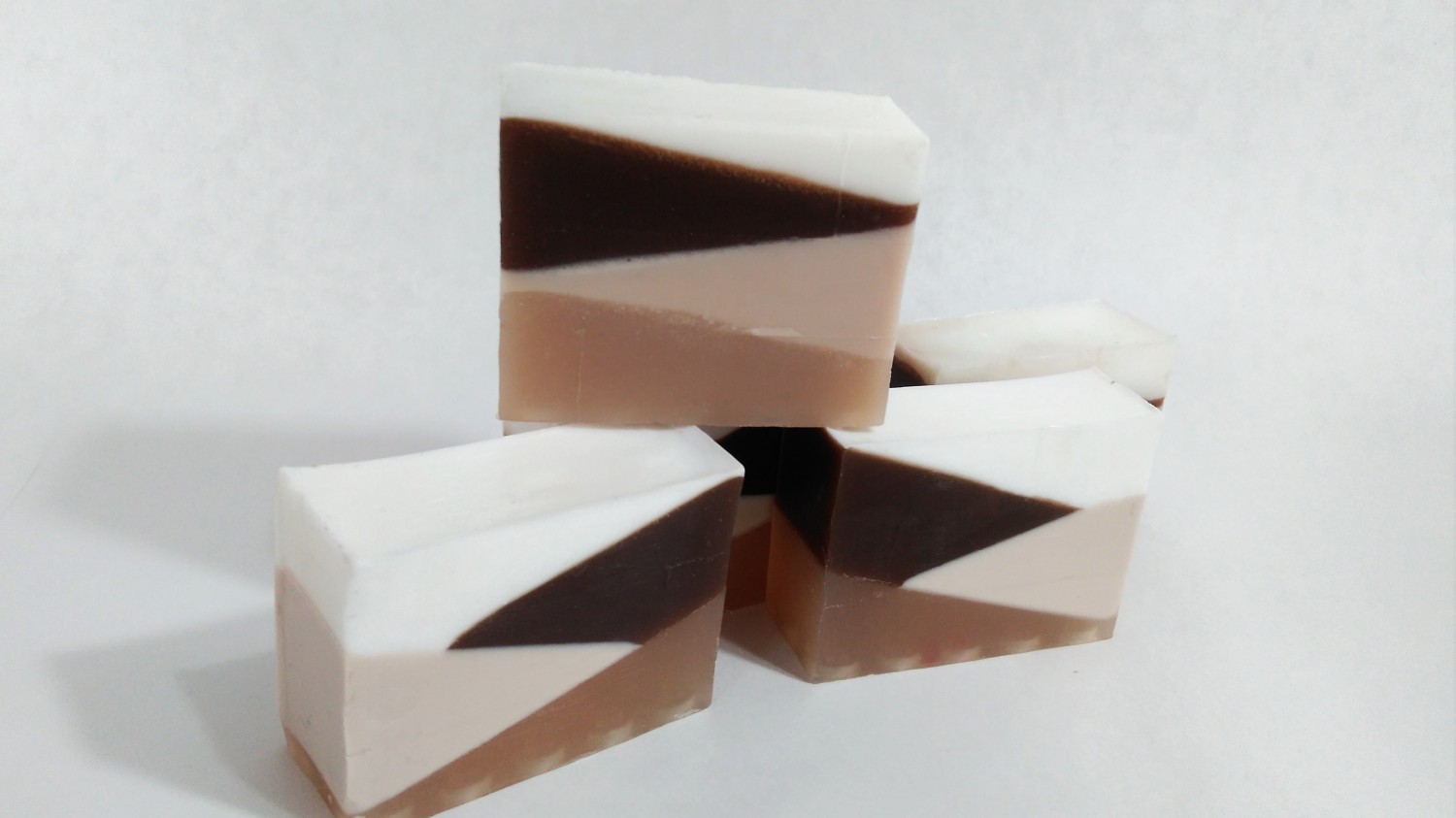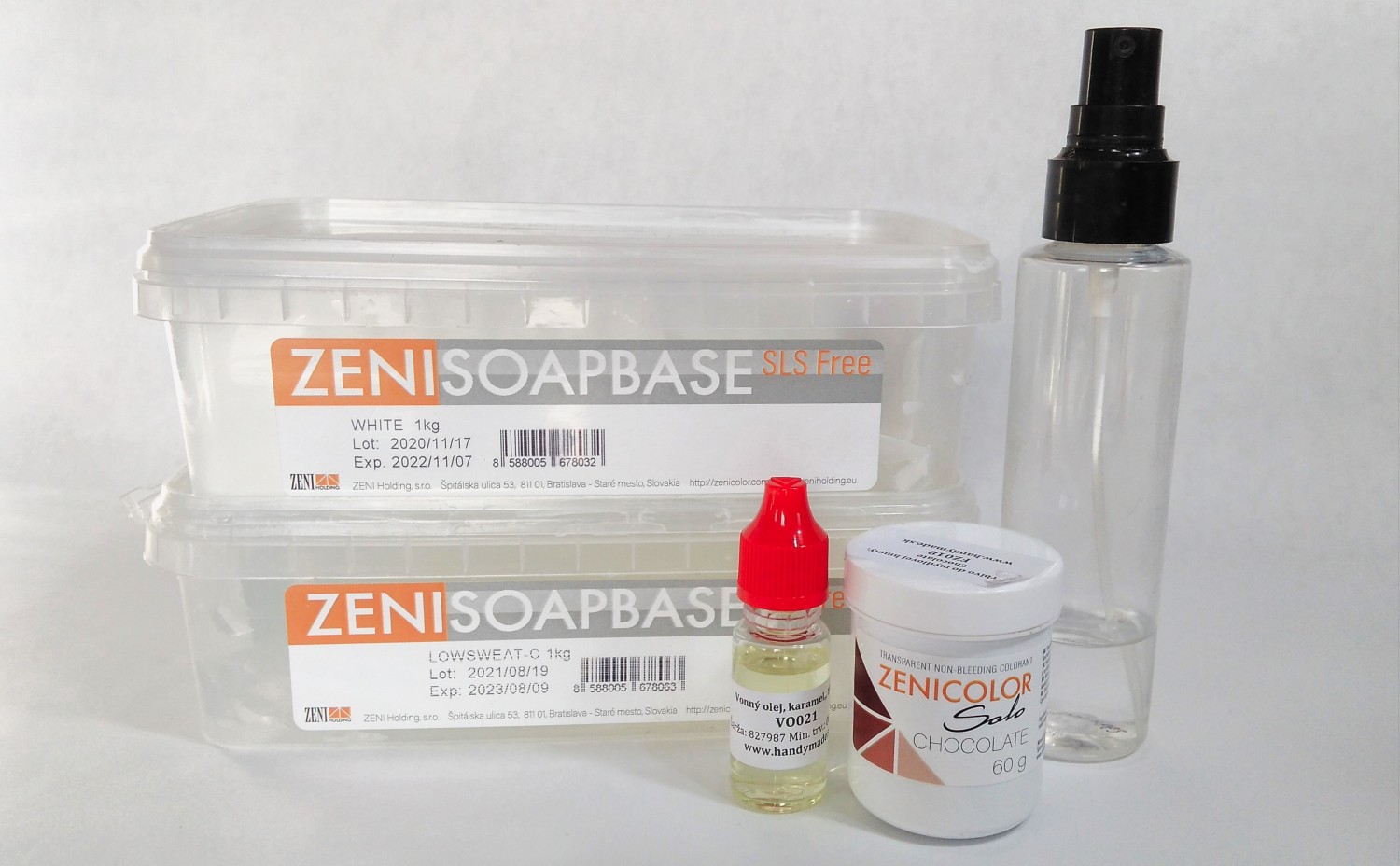Caramel soap
Caramel soap and its sweet scent will make your bath or quick shower more pleasant
Even without much experience, you can make a charming soap with an intense caramel scent in the comfort of your own home that will delight all your senses. The result will be a beautiful handmade soap that is also perfect as a small gift.

CARAMEL SOAP - INGREDIENTS
Caramel soap is made without the direct use of hydroxide. It is based on soap masses, which are pre-prepared blocks of soap that you cut to the desired weight and melt either by briefly heating in the microwave or in a water bath.
See below for the total list of ingredients, with the breakdown for each layer of soap given as you proceed to achieve the desired pattern. The soap consists of four different coloured layers of equal weight.
The amount of raw materials you need to make the soap depends on the number and size of the individual cubes, ideally use a rectangular silicone mould (e.g. in a wooden tray), which will make it easier to remove the finished soap once it has set. In the picture you can see the cubes are approx. 5x4x2 cm, weighing approx. 50 g each.
The raw materials you will need are:
Soap mass ZENIOSOAPBASE non-spreading, transparent
Soap mass ZENIOSOAPBASE white
Caramel fragrance oil
Soap colorant ZENICOLOR SOLO, chocolate
IPA (isopropyl alcohol) spray
CARAMEL SOAP - PROCEDURE
1.prepare four microwave-safe or water bath-safe bowls/trays. Each container will contain the soap mass (either pure white or a combination of white and clear) for that layer, which you will weigh according to the schedule below.
2. briefly heat the container with the soap mass for the 1st layer (the lowest layer) until the mass melts. Be careful not to boil the soap when heating in the microwave.
3. carefully remove the container, it will be hot. Slowly add colouring, stirring until desired shade is reached, finally stir in fragrance oil.
4. spray a rectangular mould,one edge of whichhas been lined with e.g. a book, just before pouring the IPA
and pour in the liquid mixture. Spray immediately with IPA to remove bubbles.
5.if the soap mixture has solidified while the dye is being added, reheat it briefly.
6.once the layers have set , tilt the mould to the other side (prop the opposite end of the mould with a book) and spray again with IPA before pouring the liquid mixture with the dye (2nd layer) and fragrance oil to ensure the layers adhere to each other.
7. repeat for the third dark brown layer.
8. when pouring the last white layer, do not tilt the mould anymore, leave it on a flat surface.
9. once set, cut the soap into cubes.
1. layer - light brown, partially transparent
Soap mass ZENIOSOAPBASE non-spreading, transparent 92,6 %
ZENIOSOAPBASE soap mass white6,4 %
Caramel fragrance oil1 %
Colouring agent for soap mass ZENICOLOR SOLO, chocolate according to desired shade
2. layer - light brown, milky
Soap mass ZENIOSOAPBASE white99 %
Caramel fragrance oil1 %
Colouring agent for soap mass ZENICOLOR SOLO, chocolate according to desired shade
3. layer - dark brown, partially transparent
Soap mass ZENIOSOAPBASE non-spreading, transparent 92,6 %
ZENIOSOAPBASE soap mass white6,4 %
Caramel fragrance oil 1 %
Colouring agent for soap mass ZENICOLOR SOLO, chocolate according to desired shade
4. layer - white
Soap mass ZENIOSOAPBASE white99 %
Caramel fragrance oil1 %
CARAMEL SOAP AND THE IMPORTANCE OF THE RAW MATERIALS USED
In order to be able to substitute ingredients or to adapt the recipe to your own requirements, it is useful to know what role the different ingredients play in the recipe. This is how you can conjure up beautiful homemade soaps that will delight not only you, but also those around you.
SOAP MOUTH
ZENIOSOAPBASE soap mass has been used for the production of the caramel soap, for good compatibility
with the corresponding dye. The non-sparking transparent soap mass has been chosen to minimize the formation of dew on the surface of the finished soap (this can also be prevented by wrapping the finished soap in plastic wrap).
However, you can also choose other types of translucent and white soaps. If possible, reach for soaps that set more slowly to give you enough time to mix in the colouring and fragrance oil before the soap hardens again. Having a slower setting mass is especially worthwhile if you are a beginner. If you are making larger batches, you can instead reach for faster setting compounds, which will reduce the time you have to wait for the layers to set.
FARBIVO
ZENIOCOLOR SOLO colorant combines well with selected soap masses, but can also be mixed into other soap masses. An alternative for this colorant is to use mica powder in brown. However, count on getting different shades. At the same time, mica is shimmery and therefore the finished soap will also be slightly shimmery.
IPA
A bubble remover or IPA is an essential helper when making soaps from soap masses. Not only does it help to remove bubbles, but spraying it on the mould or previous layer will ensure that the new layer adheres reliably.
FRAGRANCE OIL
Caramel fragrance oil was chosen for its pleasant soothing sweet scent. However, it can be substituted for any other scent, whether in fragrance or essential oil form. However, essential oils of a darker colour may slightly alter the final shade of the soap, especially the white layer, so add them to the mixture for the last layer
should not be added in this case. Alternatively, you can omit the addition of fragrance or essential oil altogether.
NOTICE
As mentioned, you can experiment with homemade recipes to achieve the desired properties. However, many factors such as humidity, temperature, quality of ingredients and storage can affect the final result.
Before using any raw material to make a cosmetic product, familiarize yourself with its properties, recommended dosage, storage conditions or safe handling. Any raw material may have the potential to cause an allergic reaction in sensitive individuals, so before using a product, we recommend that you find out if you suffer from an allergy to any of the raw materials or the overall product, e.g. by a skin test.
If you have very sensitive or very acne-prone skin, or other skin and health problems, we recommend that you consult a medical professionalbefore applying a new product to your skin, whether it is a homemade cosmetic product, a pure raw material or a commercially available product.
CARAMEL SOAP - CONCLUSION
Dear Friends,
have you ever made soap with ZENIOSOAPBASE? How did you manage?
Share your experience with us or write us your questions at marketing@handymade.sk
and we will be happy to answer you.
We look forward to hearing about your experience.
We wish you a beautiful creation.
Until the saponification, my friends.


